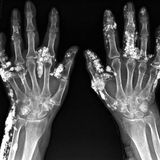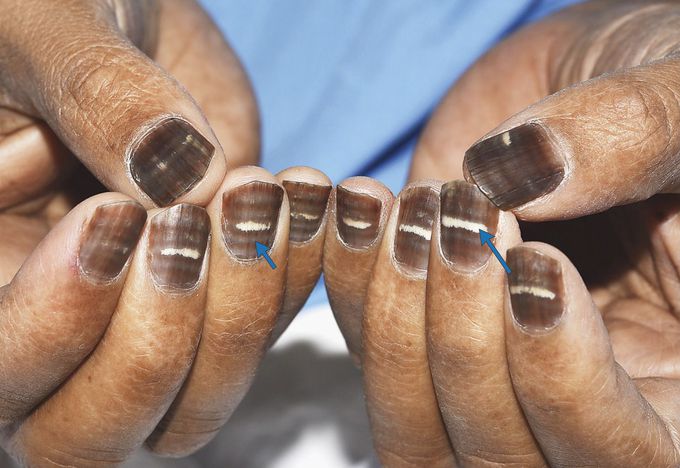


Nail Changes during Chemotherapy
A 42-year-old man who was undergoing treatment for non-Hodgkin’s lymphoma presented to the oncology clinic with changes in his fingernails. Five months earlier, he had presented with gastric-outlet obstruction and had received a diagnosis of high-grade B-cell non-Hodgkin’s lymphoma. He then completed four cycles of chemotherapy, which had included rituximab, etoposide, prednisone, vincristine, cyclophosphamide, and doxorubicin. Physical examination showed diffuse, dark brown discoloration of his fingernails (melanonychia) and two types of transverse white lines that were not palpable. The serum albumin level was 2.5 g per deciliter (reference range, 3.5 to 5.0). The opaque-appearing transverse lines (long arrow) on the fingernails are called Mees’ lines (true leukonychia), and the more translucent-appearing lines (short arrow) are called Muehrcke’s lines (apparent leukonychia). Mees’ lines develop as a result of injury to the nail matrix, whereas Muehrcke’s lines are related to abnormal nail-bed vasculature. Therefore, Mees’ lines do not diminish with compression of the nail plate, and Muehrcke’s lines do. Multiple chemotherapy agents are associated with these nail changes. Muehrcke’s lines can also occur in patients with hypoalbuminemia. After six cycles of chemotherapy, the patient had remission of the non-Hodgkin’s lymphoma. Approximately 6 months after the completion of chemotherapy, the fingernail changes resolved completely. Musa F. Alzahrani, M.B., B.S., M.H.Sc. King Saud University, Riyadh, Saudi Arabia Source: nejm.org
It means that bulemic or not enough vitamin like something to help iron and to help build muscle they also like protein plus a good eating healthy regimen is healthy talk too your primary care physician about what workout is right for you
An 80-year-old woman who resides in a nursing home presents for evaluation of fever of unknown origin. Two weeks ago, she was transferred to the nursing home after undergoing 3 months of inpatient treatment for a cardiovascular accident. After readmission, bacterial cultures grow MRSA. What is the most appropriate antibacterial choice for this patient Amoxicillin Ceftriaxone Vancomycin Erythromycin

